
Bristol Temple Meads is the oldest and largest railway station in Bristol, England. It is an important transport hub for public transport in the city. In addition to the train services there are bus services to many parts of the city and surrounding districts, and a ferry to the city centre. Bristol's other major station, Bristol Parkway, is a more recent station on the northern outskirts of the conurbation.

Bristol Parkway, on the South Wales Main Line, is in the Stoke Gifford area in the northern suburbs of the Bristol conurbation. It is 112 miles (180 km) from London Paddington. The station was opened in 1972 by British Rail, and was the first in a new generation of park and ride/parkway stations. It is the third-most heavily used station in Western England, after Bristol Temple Meads and Bath Spa. There are four platforms, and a well-equipped waiting area. The station is managed by Great Western Railway, who provide most of the trains at the station, with CrossCountry providing the rest.
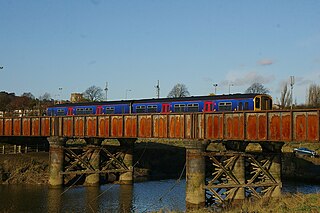
The Severn Beach line is a local railway line in Bristol and South Gloucestershire, England. It runs from Bristol Temple Meads to Severn Beach, and used to extend to Pilning. The first sections of the line were opened in 1863 as part of the Bristol Port Railway and Pier, the section through Bristol was opened in 1875 as the Clifton Extension Railway. The line has faced several threats of closure over the years, and has been reduced to single track in many places. In recent years however it has experienced a surge in passenger numbers, with a 90% increase in the years 2007–11. All services along the line are operated by Great Western Railway, mainly one train in each direction between Avonmouth and Temple Meads every 40 minutes, calling at all stations, with one train every two hours extended to Severn Beach. The line carries little freight traffic, with most of the heavy freight traffic to Avonmouth Docks being routed via the Henbury Loop Line through Filton. The line has been highlighted by Thomas Cook as one of the scenic lines of Europe.

Stapleton Road railway station is on the Severn Beach Line and Cross Country Route, serving the inner-city district of Easton in Bristol, England. It is 1.6 miles (2.6 km) from Bristol Temple Meads. Its three letter station code is SRD. As of 2018, the station has two platforms, four running lines and minimal facilities. It is managed by Great Western Railway, the seventh company to be responsible for the station, and the third franchise since privatisation in 1997. They provide all train services at the station, the standard service being a train every 40 minutes along the Severn Beach Line, an hourly service to Bristol Parkway, and another hourly service to Westbury.

Filton Abbey Wood railway station serves the town of Filton in South Gloucestershire, England, inside the Bristol conurbation. It is 4.4 miles (7.1 km) from Bristol Temple Meads. Its three letter station code is FIT. There are four platforms but minimal facilities. The station is managed by Great Western Railway, the seventh company to be responsible for the station, and the third franchise since privatisation in 1997. They provide most train services at the station, with two trains per day operated by CrossCountry. The general service level is eight trains per hour - two to South Wales, two to Bristol Parkway, two toward Weston-super-Mare and two toward Westbury.

Montpelier railway station is on the Severn Beach Line and serves the district of Montpelier in Bristol, England. It is 2.85 miles (4.59 km) from Bristol Temple Meads. Its three letter station code is MTP. The station has a single platform, serving trains in both directions. As of 2015 it is managed by Great Western Railway, which is the third franchise to be responsible for the station since privatisation in 1997. They provide all train services at the station, mainly a train every forty minutes in each direction between Bristol Temple Meads and Avonmouth.

Clifton Down railway station is on the Severn Beach line and serves the district of Clifton in Bristol, England. It is 3.9 miles (6.3 km) from Bristol Temple Meads. Its three letter station code is CFN. The station has two platforms, each serving trains in one direction only. As of 2015 it is managed by Great Western Railway, which is the third franchise to be responsible for the station since privatisation in 1997. They provide all train services at the station, mainly a train every forty minutes in each direction between Bristol Temple Meads and Avonmouth.
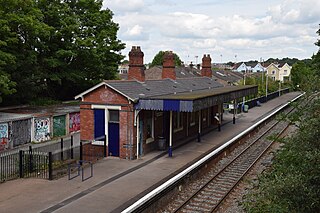
Redland railway station is on the Severn Beach Line and serves the districts of Cotham and Redland in Bristol, England. It is 3.3 miles (5.3 km) from Bristol Temple Meads. Its three letter station code is RDA. As of 2015 it is managed by Great Western Railway, which is the third franchise to be responsible for the station since privatisation in 1997. They provide all train services at the station, mainly a train every forty minutes in each direction between Bristol Temple Meads and Avonmouth.
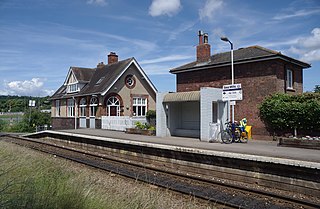
Sea Mills railway station is on the Severn Beach Line and serves the district of Sea Mills and nearby Westbury on Trym in Bristol, England. It is 6 miles (9.7 km) from Bristol Temple Meads, situated at the confluence of the River Avon and River Trym and near the A4 Bristol Portway. Its three letter station code is SML. The station has a single platform which serves trains in both directions. As of 2015 it is managed by Great Western Railway, which is the third franchise to be responsible for the station since privatisation in 1997. They provide all train services at the station, mainly a train every forty minutes in each direction between Bristol Temple Meads and Avonmouth.
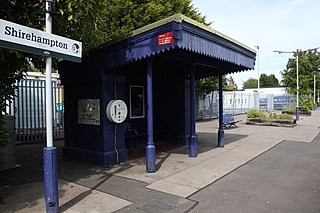
Shirehampton railway station is on the Severn Beach Line and serves the district of Shirehampton in Bristol, England. It is 7.6 miles (12.2 km) from Bristol Temple Meads. Its three letter station code is SHH. The station has a single platform which serves trains in both directions. As of 2015 it is managed by Great Western Railway, which is the third franchise to be responsible for the station since privatisation in 1997. They provide all train services at the station, mainly a train every forty minutes in each direction between Bristol Temple Meads and Avonmouth.

Avonmouth railway station is located on the Severn Beach Line and serves the district of Avonmouth in Bristol, England. It is 9.0 miles (14.5 km) from Bristol Temple Meads. Its three letter station code is AVN. The station has two platforms, on either side of two running lines. As of 2015 it is managed by Great Western Railway, which is the third franchise to be responsible for the station since privatisation in 1997. They provide all train services at the station, mainly a train every forty minutes to Bristol Temple Meads and one every two hours to Severn Beach.

St Andrew's Road railway station is located near to St Andrew's Road and serves a large industrial area near to Avonmouth, Bristol, England. The station and all trains serving it are operated by Great Western Railway.

Severn Beach railway station serves the village of Severn Beach, England. This is the terminus of the Severn Beach Line.
Bristol is a city in south west England, situated near the Bristol Channel coast, approximately 106 miles (170 km) west of London. Several factors have influenced the development of its transport network. It is a major centre of employment, retail, culture and higher education, has many historic areas, and has a history of maritime industry. The city has a population of 400,000, with a metropolitan area of 550,000, and lies at the centre of the former County of Avon, which includes many dormitory towns, and has a population of one million. Additionally, it has the seventh highest population density of any English district.

Lawrence Hill railway station is on the Severn Beach Line and Cross Country Route, serving the inner-city districts of Easton and Lawrence Hill in Bristol, England. It is 1.0 mile (1.6 km) from Bristol Temple Meads. Its three letter station code is LWH. As of 2018, the station has two platforms, four running lines and minimal facilities. It is managed by Great Western Railway, the seventh company to be responsible for the station and the third franchise since privatisation in 1997. They provide all train services at the station, the standard service being a train every 40 minutes along the Severn Beach Line, an hourly service to Bristol Parkway and another hourly service to Westbury.
Rail services in the West of England refer to passenger rail journeys made in the Bristol commuter area. 26 million passenger rail journeys were made in 2018-19 within the Gloucestershire, Wiltshire and Bristol/Bath region.
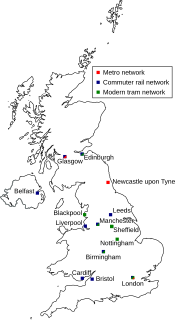
Urban or suburban rail plays a key role in public transport in many of the United Kingdom's major cities. Urban rail refers to the train service between city centres and suburbs or nearby towns that acts as a main mode of transport for travellers on a daily basis.

MetroWest, formerly known as the Greater Bristol Metro, is a project to improve the rail services in Bristol, England, and the surrounding region. It was first proposed at First Great Western's Stakeholder Event in March 2008. The aim of the project is to develop half-hourly services through central Bristol which will also serve the surrounding West of England region. Transport campaigning groups Friends of Suburban Bristol Railways (FoSBR) and Transport for Greater Bristol are actively supporting the proposal, as are the three unitary authorities under the West of England Combined Authority and North Somerset Council.

Bristol Supertram was a proposed light rail system for the Bristol and South Gloucestershire regions of England. In 2001, the project was given backing from the government to build a line that would link the city centre with the North Bristol region, but the project was cancelled in 2004.
Friends of Suburban Bristol Railways (FoSBR) is a Bristol-based campaign group, calling for better rail transport in the Bristol area.




















